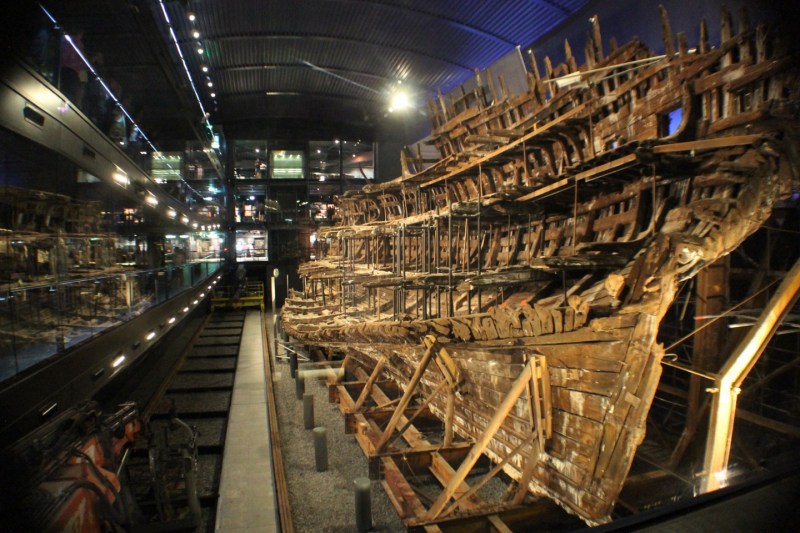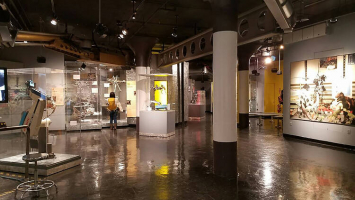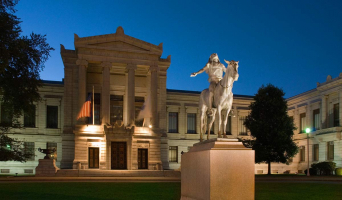Top 10 Best Museums to Visit in England
If you've ever visited a museum, you know that they're simply storage facilities for historical art and antiques, and they may be a haven for the proper ... read more...individuals. There are, however, museums that cater to everyone, not just history aficionados. From awe-inspiring natural history collections to engaging and interactive displays, the UK has some of the top museums in the world. Here's a list of must-see museums that will keep everyone pleased, whether you're looking for a cultural fix or just something to do with the kids over the school holidays.
-
The Natural History Museum in London houses a diverse collection of specimens from several areas of natural history. The Science Museum and the Victoria and Albert Museum are the other two main institutions on Exhibition Road in South Kensington. The Natural History Museum, on the other hand, has its main entrance on Cromwell Road.
The museum has 80 million specimens of life and earth science in five primary collections: botany, entomology, minerals, paleontology, and zoology. The museum is a research center that focuses on taxonomy, identification, and conservation. Given the institution's history, many of the collections, such as specimens gathered by Charles Darwin, are both historically and scientifically significant. The huge Diplodocus cast that dominated the vaulted central hall before it was replaced in 2017 with the skeleton of a blue whale hanging from the ceiling made the museum notable for its exhibition of dinosaur bones and magnificent architecture—sometimes labeled a cathedral of nature.
The Natural History Museum Library has significant collections of books, periodicals, manuscripts, and artwork related to the scientific departments' work and study; admission to the library is by appointment only. The museum is regarded as the world's preeminent center for natural history and associated study.
Location: Cromwell Road, London, England SW7 5BD
Website: nhm.ac.uk

Natural History Museum 
Natural History Museum -
The International Slavery Museum is a museum in Liverpool, England that focuses on the transatlantic slave trade's history and consequences. The Merseyside Maritime Exhibit's museum comprises three primary halls that focus on the life of people in West Africa, their eventual enslavement, and their ongoing struggle for liberation. In addition, the museum covers subjects such as modern-day slavery, racism, and prejudice.
According to National Museums Liverpool, the new museum focuses on individual experiences, incorporating accounts from captives and slave traders. They offer a peaceful spot for introspection and reflection, as well as a shrine to the enslaved's ancestors.
The building of a new visitor-focused information center featuring a performance, public lecture, and debate program is planned for the second phase. The institution will provide a research facility for visiting researchers as well as access to the archival holdings of the National Museums Liverpool. There will be a digital repository of material relating to the transatlantic slave trade.Location: Albert Dock, Liverpool Waterfront, Liverpool L3 4AX
Website: liverpoolmuseums.org.uk/international-slavery-museum

International Slavery Museum 
International Slavery Museum -
The British Museum is a public museum in London's Bloomsbury district dedicated to human history, art, and culture. It has one of the world's largest and most comprehensive permanent collections of eight million pieces. It tells the story of human civilization from its inception to the current day. The British Museum was the world's first public national museum.
The Museum was founded in 1753, based primarily on the collections of Sir Hans Sloane, an Anglo-Irish physician and scientist. It initially opened its doors to the public at Montagu House, on the same site, in 1759. The development of the museum during the next 250 years was primarily due to British colonisation, and it resulted in the establishment of various branch institutions, or autonomous spin-offs, the first of which was the Natural History Museum in 1881. Its ownership of a tiny fraction of its most renowned artifacts, most notably the Elgin Marbles of Greece and the Rosetta Stone of Egypt, is contested and continues to be the topic of international controversy through repatriation demands.
Location: Great Russell Street, London, England WC1B 3DG
Website: britishmuseum.org

The British Museum 
The British Museum -
Beamish Museum is England's first regional open-air museum and is located in Beamish, near Stanley in County Durham. The notion of a living museum was invented by Beamish. It was also an early example of the now usual practice of museums enabling people to touch exhibits by showing replicas or interchangeable pieces.
The museum's guiding premise aims to maintain an example of daily life in urban and rural North East England at the early twentieth century's peak of the industry. Much of the restoration and interpretation dates from the late Victorian and Edwardian periods, as well as areas of the countryside that were influenced by the industrial revolution beginning in 1825. It employs a mix of translocated, original, and replica buildings, a significant collection of antiquities, functional vehicles and equipment, animals, and costumed interpreters on its 350-acre (140-hectare) estate. Since its inception in 1972, the museum has garnered several honors and has influenced other living museums. It serves as an instructional tool while also assisting in the preservation of several historic and endangered northern cattle breeds.
Location: Regional Resource Centre, Beamish, County Durham DH9 0RG
Website: beamish.org.uk

Beamish 
Beamish -
The Mary Rose Museum is a historical museum maintained by the Mary Rose Trust. The Mary Rose Museum is located at the Portsmouth Historic Dockyard, where you may not only learn about Henry VIII's famed ship but also stand just steps from it. In 1982, the Mary Rose was rescued from the depths of the Solent and meticulously preserved for future generations. The massive floor-to-ceiling windows and air-locked observation terrace provide unparalleled views of a 16th-century battleship.
The ship hall was closed in September 2009 to allow for the construction of a new museum, which opened in May 2013. Wilkinson Eyre, Perkins+Will designed the Mary Rose Museum (2013), which was built by Warings Construction. The museum was erected above the ship in the dry dock, which is a listed monument, which made building difficult. The hull was conserved within an enclosed "hotbox" while the museum was being built. The polyethylene glycol sprays were switched off in April 2013, and the controlled air-drying process commenced. The "hotbox" walls were removed in 2016, and the ship was put on exhibit behind glass after reopening. The museum was closed for nine months in 2016 as a £5.4 million renovation was completed, allowing visitors to view the ship without being divided by a glass wall.
Location: No 3 Dock, Main Road, H.M Naval Base, Portsmouth PO1 3PY, England
Website: maryrose.org

The Mary Rose Museum 
The Mary Rose Museum -
The National Justice Museum (previously the Galleries of Justice Museum and, historically, the Shire Hall and County Gaol) is an independent museum in Nottingham, England, located on High Pavement in the Lace Market district. The museum is located in a former Victorian courthouse, prison, and police station, making it a historically significant location where someone might be arrested, tried, condemned, and killed. The courtrooms originate from the 14th century and the gaol from 1449. The museum is a registered charity and the building is a Grade II* listed structure.
The National Justice Museum, housed in Nottingham's centuries-old Shire Hall and County Gaol, explores the history and presence of law and justice in the United Kingdom. You'll meet numerous historical characters—all with a story to tell—watch a replica of a major court trial, hear about prison reform, and—if you're daring enough—join one of the scary ghost tours—during your stay.
Location: High Pavement, Nottingham, England NG1 1HN
Website: nationaljusticemuseum.org.uk

National Justice Museum 
National Justice Museum -
The Science Museum is a significant museum in South Kensington, London, located on Exhibition Road. It was founded in 1857 and is now one of the city's most popular tourist destinations, with 3.3 million tourists each year. The Science Museum, like other publicly supported national museums in the UK, does not charge admission, however, visitors are encouraged to give a gift if they are able. Admission to temporary exhibitions may be charged. It is one of the Science Museum Group's five museums.
Palgrave Macmillan, a major academic publisher, released the official centennial history of the Science Museum on April 14, 2010. Science for the Nation: Perspectives on the History of the Science Museum is the first comprehensive history of the Science Museum since 1957. It is a collection of individual perspectives on various parts of the Science Museum's history by Science Museum personnel and external academic historians. The first five chapters trace the museum's history from the Brompton Boilers in the 1860s to the completion of the Wellcome Wing in 2000, albeit it is not a chronological history in the traditional sense. The next eight chapters deal with various aspects of the Museum's growth.
Location: Exhibition Road, London, England SW7 2
Website: sciencemuseum.org.uk

Science Museum 
Science Museum -
SS Great Britain is a museum ship and a former passenger steamer that was technologically sophisticated in her day. From 1845 to 1854, she was the world's biggest passenger ship. She was built for the Great Western Steamship Company's transatlantic service between Bristol and New York City and was designed by Isambard Kingdom Brunel (1806–1859). While earlier ships used iron or had a screw propeller, Great Britain was the first to combine these qualities in a huge ocean-going vessel. In 1845, she became the first iron steamship to traverse the Atlantic Ocean in 14 days.
The ship is 322 feet long (98 meters) and has a displacement of 3,400 tons. She was propelled by two inclined two-cylinder direct-acting engines with twin high-pressure (diameter unknown) and twin low-pressure 88 in (220 cm) bore cylinders, all with 6-foot (1.8 m) stroke cylinders. She was also given supplementary masts to help with sail power. The four decks accommodated a crew of 120 people as well as 360 guests in staterooms, dining rooms, and promenade saloons.
Location: Great Western Dockyard Gas Ferry Road, Bristol, England BS1 6TY
Website: ssgreatbritain.org

Brunel's SS Great Britain 
Brunel's SS Great Britain -
The National Railway Museum is part of the Science Museum Group and is located in York. The museum recounts the story of rail travel in the United Kingdom and its social influence. The national collection of historically notable railway cars, including the Mallard, Stirling Single, Duchess of Hamilton, and a Japanese bullet train, is housed there. The National Train Museum also has a broad collection of other items, ranging from a family recipe book used in George Stephenson's home to a video depicting a "never-stop railway" created for the British Empire Exhibition. Many honors have been bestowed upon it, including the European Museum of the Year Award in 2001.
The museum is preparing to embark on a significant site development project in 2019. The National Railway Museum will construct a new entry building to join the two different components of the museum as part of the York Central redevelopment, which would redirect Leeman Road. Simultaneously, the area surrounding the museum will be planted to provide public areas.
Location: Leeman Road, York, England YO26 4XJ
Website: railwaymuseum.org.uk

National Railway Museum 
National Railway Museum -
The National Collection of Arms and Armour is on exhibit in the Royal Armouries Museum in Leeds, West Yorkshire, England. The Tower of London, its original home, Fort Nelson, Hampshire, for the display of the National Collection of Artillery, and permanent galleries within the Frazier History Museum in Louisville, Kentucky, USA, are all part of the Royal Armouries network of museums. The Department for Culture, Media, and Sport sponsors the Royal Armouries, which is a non-departmental public entity.
The Royal Armouries Museum is a purpose-built museum in Leeds Dock that opened in 1996 for £42.5 million. The Royal Armouries' collection was originally on display or in storage at the Tower of London, where it still has a presence with exhibits in the White Tower. Entry is free, as it is at all UK National Museums, however certainly added attractions are not.
Location: Armouries Drive, Leeds, England LS10 1LT
Website: royalarmouries.org

Royal Armouries Museum 
Royal Armouries Museum































